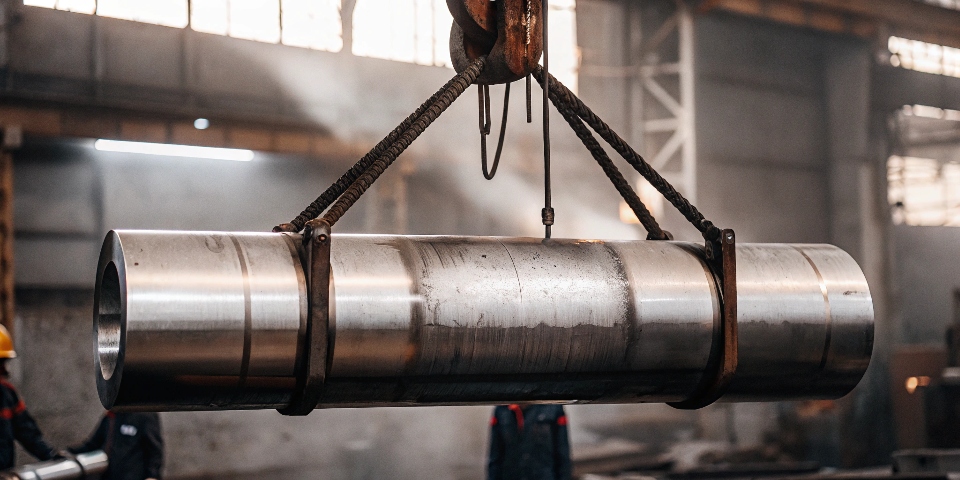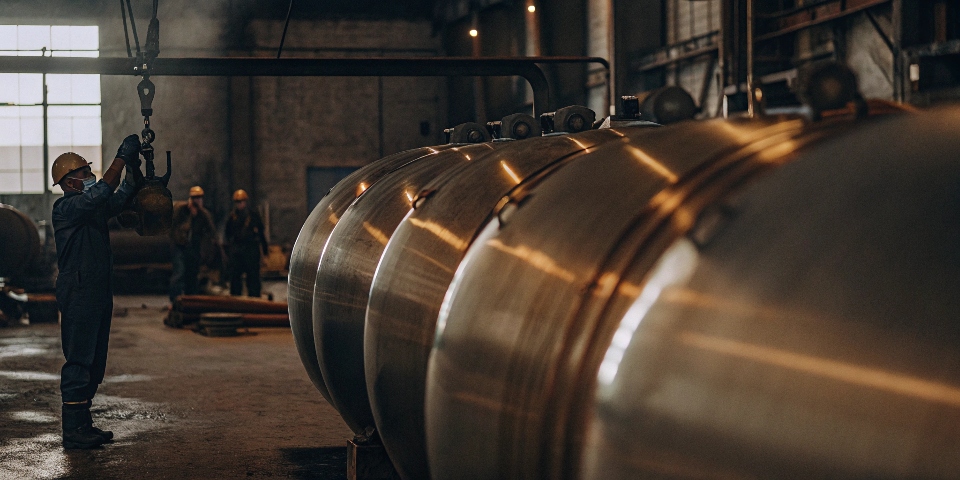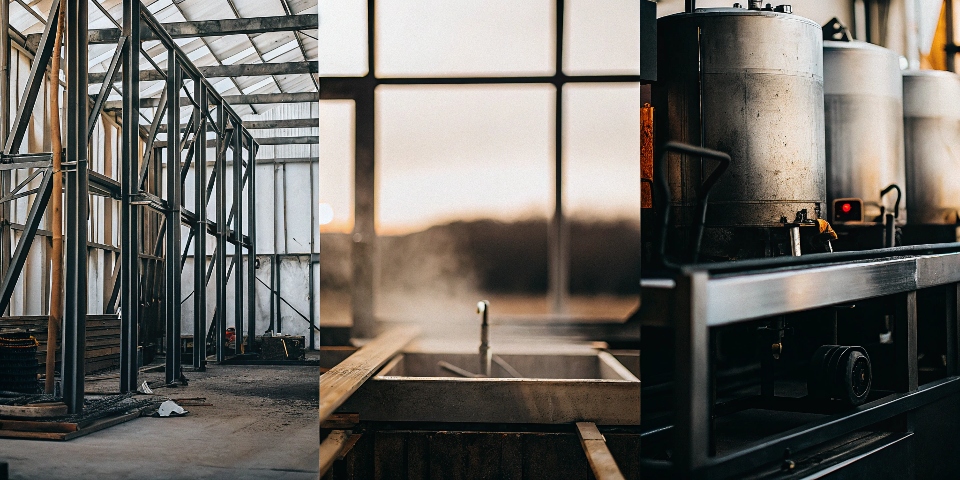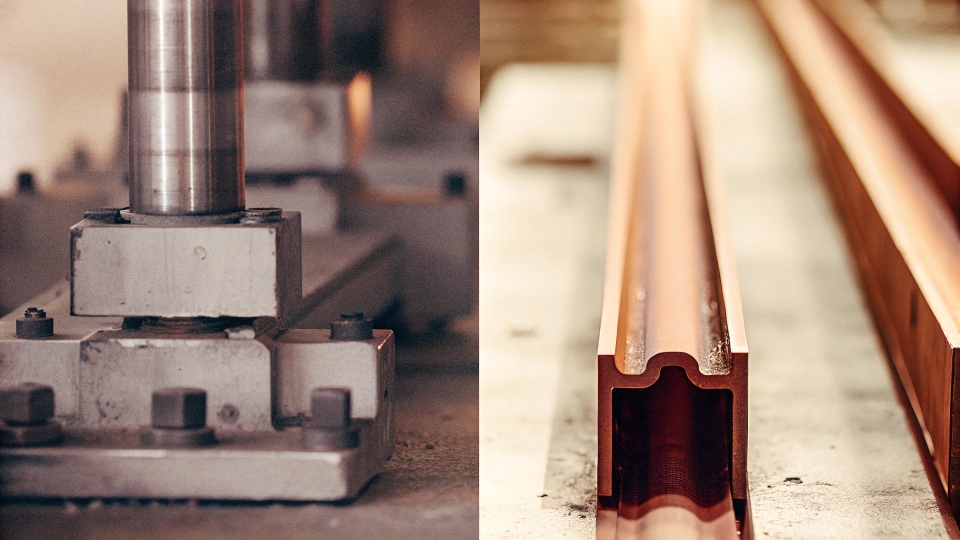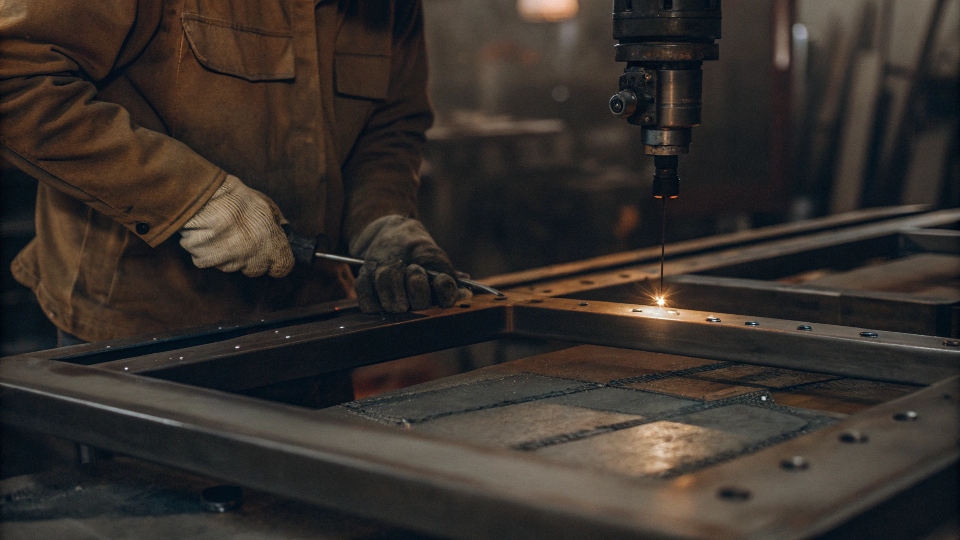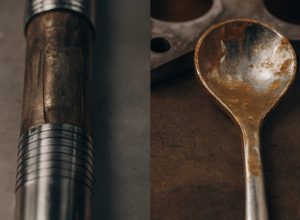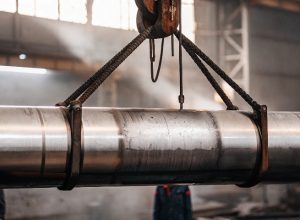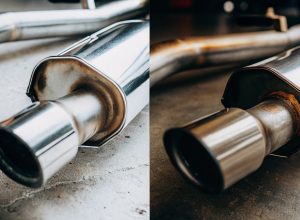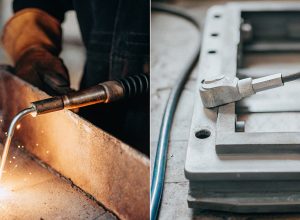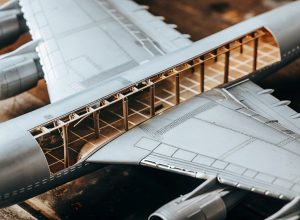¿Le confunden términos como fabricación y fresado? Esta confusión puede dar lugar a errores en el proyecto y a pedidos de materiales equivocados. Vamos a aclararle estos procesos de fabricación clave.
La fabricación de metales es un amplio proceso de construcción de estructuras metálicas mediante corte, conformado y unión. En cambio, el fresado de acero es un proceso de mecanizado específico que utiliza fresas giratorias para eliminar material de una pieza de acero. Son fundamentalmente diferentes, aunque ambos se utilizan en la fabricación.
Para entender realmente la diferencia, hay que tener una idea clara de lo que significa realmente "fabricación de metales". El término es amplio y la gente de mi fábrica lo utiliza para describir toda una serie de acciones. Es más que una sola cosa. Es un viaje desde el metal en bruto hasta el producto acabado. Analicemos qué es la fabricación, cómo se clasifica y cómo se compara con otros procesos críticos como el mecanizado. Esto le ayudará a hablar con confianza con ingenieros y proveedores.
¿Qué se entiende por fabricación de metales?
¿Los requisitos del proyecto resultan confusos debido a definiciones vagas? Esto puede hacer que comunique mal sus necesidades a los proveedores. He aquí una definición clara y práctica desde la fábrica.
La fabricación de metales es el proceso completo de transformación de metales en bruto en productos acabados. Esto se hace cortando, doblando y ensamblando. En mi planta utilizamos estos métodos para producir 3.500 toneladas de titanio al año para muchas industrias.
En esencia, la fabricación de metales consiste en construir. Se parte de materiales metálicos comunes, como chapas, placas o barras, y se construye algo nuevo. Es un proceso creativo guiado por planos de ingeniería precisos. Lo veo todos los días en nuestras instalaciones de Baoji. Cogemos la esponja de titanio en bruto, la fundimos, la formamos en lingotes y luego la fabricamos en piezas para plantas químicas o aviones. El proceso puede dividirse en tres etapas principales.
Las etapas de la fabricación
| Escenario | Descripción | El ejemplo de mi planta |
|---|---|---|
| Corte | Es el primer paso en el que la materia prima se corta al tamaño y la forma requeridos. Puede hacerse por cizallamiento, aserrado o con métodos avanzados. | Utilizamos el corte por chorro de agua a alta presión para las placas de titanio. Corta con precisión sin crear una zona afectada por el calor, lo que protege las propiedades del metal. |
| Formando | Una vez cortado, el metal se dobla, se estampa o se le da forma. Para ello se suele utilizar presión y matrices. En el caso de algunos metales, es necesario calentarlos para hacerlos más maleables. | Nuestro equipo utiliza forja isotérmica1 para piezas complejas de titanio. Esto significa que calentamos la pieza y la matriz a la misma temperatura, lo que nos permite moldear la resistente aleación con una precisión increíble. |
| Montaje | Por último, se unen las piezas separadas. El método más habitual es la soldadura, pero también se utilizan el remachado o la unión con adhesivos. | El ensamblaje del titanio es muy especializado. Debemos soldarlo en un entorno de gas argón inerte. Así se evita que el metal caliente reaccione con el oxígeno o el nitrógeno del aire, lo que haría que la soldadura fuera quebradiza y débil. |
¿Cuáles son los tres tipos de fabricación de metales?
¿Le parece que la "fabricación" es un único y gran proceso? Esta simple visión oculta importantes diferencias que pueden afectar al coste, la calidad y los plazos de su proyecto. Veamos las tres categorías principales.
Los tres tipos principales de fabricación son estructural, industrial y comercial. Cada uno sirve para un fin distinto, desde construir esqueletos para rascacielos hasta crear equipos a medida para una planta química o piezas para productos comerciales.
Pensar en la fabricación por categorías ayuda a adaptar el proceso al producto. Como ingeniero, tengo que tener en cuenta la aplicación final para recomendar el material y el método de fabricación adecuados. Por ejemplo, los requisitos de una viga estructural son muy distintos de los de un reactor químico de gran pureza. La escala, los materiales y la precisión necesarios varían mucho. Estas diferencias influyen directamente en la elección del socio de fabricación y en el coste total del proyecto. Analicemos cada tipo.
Tipos de fabricación
| Tipo de fabricación | Objetivo principal | Materiales comunes | Ejemplos de productos |
|---|---|---|---|
| Estructural | Para crear los "huesos" de grandes proyectos como edificios y puentes. La atención se centra en la resistencia y la capacidad de carga. | Acero al carbono (vigas en I, barras, chapas) | Armazones de edificios, plataformas, estructuras de soporte, componentes de puentes. |
| Industrial | Construir equipos pesados que se encargan del procesamiento, la fabricación o el almacenamiento. A menudo se hace hincapié en la durabilidad y la resistencia a la presión, la temperatura o la corrosión. | Acero inoxidable, acero al carbono, titanio, circonio | Recipientes a presión, reactores químicos, tanques industriales, intercambiadores de calor, grandes equipos de manipulación de materiales. |
| Comercial | Crear productos para empresas comerciales o, a veces, para uso directo del consumidor. A menudo, además de la función, se presta especial atención a la estética y el acabado de las superficies. | Acero inoxidable, aluminio | Superficies de cocinas de restaurantes, mobiliario de tiendas, barandillas arquitectónicas, paneles de electrodomésticos. |
Mi trabajo se centra en la fabricación industrial. Cuando una jefa de producto como Lisa necesita un depósito para un producto químico muy corrosivo, no puede utilizar acero estándar. Necesita un material como el titanio. Nuestra planta suministra la placa de titanio en bruto y un fabricante industrial especializado la corta, moldea y suelda para darle forma final, siguiendo estrictos códigos como ASME.
¿Cuál es la diferencia entre fabricación de acero y fabricación de metal?
¿La gente con la que trabaja utiliza "fabricación de acero" y "fabricación de metal" como si significaran lo mismo? Esta confusión tan habitual puede hacerle pasar por alto materiales especializados como el titanio.
La fabricación de acero es una especialidad dentro de la categoría más amplia de fabricación de metales. La fabricación de metales abarca todos los metales, incluidos el aluminio, el cobre y aleaciones como el titanio, mientras que la fabricación de acero se centra únicamente en el trabajo con acero.
La forma más sencilla de verlo es la siguiente: toda la fabricación de acero es fabricación de metal, pero no toda la fabricación de metal es fabricación de acero. Es una cuestión de especialización. Un taller que dice que es un "fabricante de acero" le está diciendo que su experiencia, equipos y procesos están optimizados para el acero. Son expertos en soldar acero al carbono o en conformar acero inoxidable. Sin embargo, mi planta trabaja con titanio y circonio. Se consideran metales exóticos o reactivos. Requieren conocimientos y equipos totalmente distintos. No se puede llevar una placa de titanio a un taller de acero estándar y esperar buenos resultados. Las diferencias de proceso son significativas.
Diferencias de proceso: Acero y titanio
| Etapa del proceso | Fabricación de acero estándar | Fabricación de titanio |
|---|---|---|
| Soldadura | Puede realizarse al aire libre. Es habitual la soldadura MIG o TIG estándar. El riesgo de contaminación es menor. | Debe realizarse en un escudo de gas argón inerte. Cualquier exposición al aire arruina la soldadura. Requiere conocimientos y equipos especializados de soldadura TIG. |
| Formando | A menudo puede conformarse en frío o curvarse a temperatura ambiente utilizando prensas plegadoras estándar. | A menudo requiere calor para formarse, ya que es menos dúctil. Nuestro forja isotérmica1 es un ejemplo de esta necesidad de alta temperatura. |
| Corte | Suelen cortarse con plasma, oxicorte o sierras abrasivas. Son métodos rápidos y rentables. | A menudo requiere sierras de cinta o de chorro de agua con refrigerante y velocidades de hoja específicas para evitar la acumulación de calor y la contaminación del material. |
| Contaminación | Menos sensible a la contaminación de la superficie por elementos como aceite, suciedad o partículas de hierro. | Extremadamente sensible. Incluso una huella dactilar en el metal antes de soldar puede introducir impurezas y crear un punto débil. |
Por eso, cuando Lisa necesita una pieza fabricada con uno de nuestros grados de titanio, siempre le recomiendo que trabaje con un fabricante que tenga experiencia demostrada con metales reactivos. Es un mundo diferente al de la fabricación estándar de acero.
¿Qué diferencia hay entre la fabricación de metales y el mecanizado?
¿Fabricación y mecanizado le suenan a lo mismo? Confundir ambas cosas puede significar que especifique un proceso que no puede ofrecer la precisión o las tolerancias que necesita su producto. Tracemos una línea clara.
La fabricación de metales da la forma general a un producto cortando, doblando y soldando piezas. El mecanizado es un proceso sustractivo que refina una pieza hasta alcanzar sus dimensiones finales precisas utilizando herramientas como fresadoras y tornos.
Piense en ello como un flujo de trabajo en dos pasos. La fabricación crea la estructura y el mecanizado la precisión. En mi trabajo de I+D, recurrimos a ambos. Por ejemplo, podemos fabricar una gran pieza de forja de forma casi neta para un cliente del sector aeroespacial. Esta pieza tiene casi la forma correcta, pero no tiene las dimensiones exactas ni las superficies lisas necesarias para encajar en el motor de un avión. Ahí es donde entra en juego el mecanizado. La pieza forjada se envía a un centro de mecanizado CNC. Allí, herramientas controladas por ordenador eliminan cuidadosamente pequeñas cantidades de metal para conseguir las tolerancias extremadamente ajustadas y el perfecto acabado superficial que exigen las normas aeroespaciales. La fabricación supone 95% del camino; el mecanizado aporta los 5% finales de precisión crítica.
Comparación entre fabricación y mecanizado
| Característica | Fabricación de metales | Mecanizado de metales |
|---|---|---|
| Objetivo principal | Creación de la forma y la estructura generales. | Conseguir una alta precisión, tolerancias estrechas y un acabado superficial específico. |
| Tipo de proceso | Formativo (plegado), Aditivo (soldadura) y desbaste. | Sustractiva (eliminación de material). |
| Procesos clave | Soldadura, plegado, cizallado, laminado. | Fresado, torneado (torno), taladrado, rectificado. |
| Resultado final | Conjunto o estructura completa, como un armazón o un depósito. | Componente acabado con características precisas, como un orificio roscado o una superficie de apoyo. |
| Tolerancia típica | Tolerancias más holgadas, a menudo medidas en milímetros o fracciones de pulgada. | Tolerancias muy estrechas, a menudo medidas en micrómetros o milésimas de pulgada. |
Volviendo a la pregunta original, el "fresado de acero" es un tipo de mecanizado que se realiza en acero. Es un proceso de precisión y muy diferente de la fabricación de metales, que es un proceso de construcción estructural.
Conclusión
Comprender la fabricación, el mecanizado y el fresado le ayuda a comunicarse con claridad. Esta claridad le permite elegir el proceso y el material adecuados, como el titanio, para sus aplicaciones industriales más exigentes.

